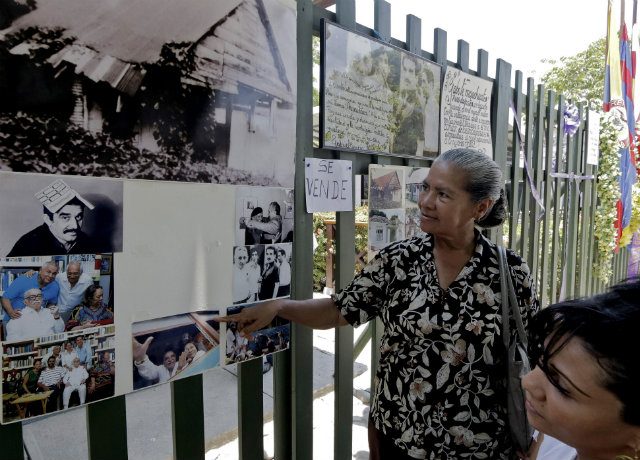SUMMARY
This is AI generated summarization, which may have errors. For context, always refer to the full article.

ARACATACA, Colombia – In his sleepy, tropical home town, the people who knew the late Nobel-winner Gabriel Garcia Marquez as a child are greeting his death with warm memories and hope.
“His grandfather, who was the colonel, kept him in the house a lot, very protective. And (Garcia Marquez) just came out to go to school,” recalled Anibal Calle, who knew the literature laureate as a very small boy.
“At that time, the teacher would stop by their home and take him to school by the hand,” said the elderly Calle, glancing at the picket fence across the street that encloses the leafy patio of the Garcia Marquez family home.
Garcia Marquez, whose “magical realism” told epic stories of love, family and dictatorship in Latin America, died Thursday aged 87 in Mexico City. He lived there for decades. (READ: World leaders, writers pay tribute to Garcia Marquez)
Born March 6, 1927, in this inland outpost in northern Colombia’s tropical Magdalena region, not far from the Caribbean, Garcia Marquez was the son of a telegraph operator.
“Gabo,” as many friends called him, was raised by his grandparents and aunts in a tropical culture influenced by the heritage of Spanish settlers, indigenous people and black Colombians.
Aracataca was, and still is, the kind of small town where a dog can nap in the middle of the street and little is likely to wake him up.
His exotic yet intimate back-of-the beyond home town inspired his writing, including his masterpiece, “One Hundred Years of Solitude,” which was translated into 35 languages and sold more than 30 million copies.
The book, published in 1967, is a historical and literary saga about a family from the imaginary Caribbean coast-region village of Macondo between the 19th and 20th century.
It was rich in “magical realism,” which Garcia Marquez described as the notion that, behind reality as we perceive it, there is much more going on that we do not understand.
Aracataca is Macondo
Here in his home town, friends and admirers reacted to Garcia Marquez’s death not with the sobbing, sadness or mourning more typical of Spanish and Andean cultures.
Instead the tone here was cheery and hopeful, traits seen in Colombia as typical of the Caribbean coast. That same upbeat cheer was a big part of Garcia Marquez’s personality.
Elvia Vizcaino remembers when Garcia Marquez came back for a visit in 1983, after winning his Nobel prize a year earlier.
“My husband, who was better known as ‘Monkey’ Todaro, when he had had a couple of drinks under his belt, went up to Gabo and asked him for a bottle of rum. He kept hounding (Garcia Marquez) around asking for one, until finally Gabo asked him for a paper on which to write down an I.O.U.”
“This is good for 10 bottles of rum for Monkey Todaro” reads the note signed by the Nobel-winner, which Todaro’s widow cherishes to this day.
“The best part was when my husband looked at it and realized what it said – and he asked Gabo ‘hey, where am I going to be able to cash this in?’ And (Garcia Marquez) shot back ‘In Stockholm,'” she said, bursting into laughter.
“Most of Garcia Marquez’s stories are from here. Macondo is the literary stand in, but Aracataca is Macondo,” said Fabian Marriaga with a group of nodding locals under a hot midday sun.
Ride the Gabo train?
Marriaga, a former cultural official here, was behind the drive to get the author back to Aracataca on what was his last visit in 2007.
“The streets were packed. People were everywhere, but Gabo did not want the police to put up any security; instead he asked for the schoolkids to cheer for him out on the street,” he recalled.
Garcia Marquez arrived on a yellow train he mentions in his works. Since 1970, it had been used only to ship coal, but it was used to bring him home specially for the occasion.
Many locals are hoping the train can be revived as part of a tourist package that would connect Aracataca and Santa Marta, a coastal resort city with a busy airport.
The yellow train would bring “some prosperity when more tourists come” to the author’s birthplace and inspiration, said Jakeline Massi, 35.
The town, which now has grown to 46,000, has four small guest houses.
“The train would bring in some investment, hotels, jobs… Now that Gabo has passed, however sad it is, it may help get the train going and promote tourism here,” said Dania Todaro, whose father, “Monkey’, passed away in 1996 without having had the chance to cash in his IOU for 10 bottles of rum. – Rappler.com
Add a comment
How does this make you feel?
There are no comments yet. Add your comment to start the conversation.